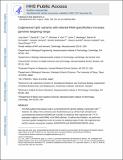Engineered Cpf1 variants with altered PAM specificities
Author(s)
Schneider, Martin W; Yamano, Takashi; Nishimasu, Hiroshi; Nureki, Osamu; Crosetto, Nicola; Gao, Linyi; Cox, David Benjamin Turitz; Yan, Winston Xia; Manteiga, John Colonnese; Zhang, Feng; ... Show more Show less
Downloadnihms877403.pdf (809.1Kb)
PUBLISHER_POLICY
Publisher Policy
Article is made available in accordance with the publisher's policy and may be subject to US copyright law. Please refer to the publisher's site for terms of use.
Terms of use
Metadata
Show full item recordAbstract
The RNA-guided endonuclease Cpf1 is a promising tool for genome editing in eukaryotic cells. However, the utility of the commonly used Acidaminococcus sp. BV3L6 Cpf1 (AsCpf1) and Lachnospiraceae bacterium ND2006 Cpf1 (LbCpf1) is limited by their requirement of a TTTV protospacer adjacent motif (PAM) in the DNA substrate. To address this limitation, we performed a structure-guided mutagenesis screen to increase the targeting range of Cpf1. We engineered two AsCpf1 variants carrying the mutations S542R/K607R and S542R/K548V/N552R, which recognize TYCV and TATV PAMs, respectively, with enhanced activities in vitro and in human cells. Genome-wide assessment of off-target activity using BLISS indicated that these variants retain high DNA-targeting specificity, which we further improved by introducing an additional non-PAM-interacting mutation. Introducing the identified PAM-interacting mutations at their corresponding positions in LbCpf1 similarly altered its PAM specificity. Together, these variants increase the targeting range of Cpf1 by approximately threefold in human coding sequences to one cleavage site per ~11 bp.
Date issued
2017-06Department
Institute for Medical Engineering and Science; Massachusetts Institute of Technology. Department of Biological Engineering; Massachusetts Institute of Technology. Department of Biology; Massachusetts Institute of Technology. Department of Brain and Cognitive Sciences; McGovern Institute for Brain Research at MITJournal
Nature Biotechnology
Publisher
Nature Publishing Group
Citation
Gao, Linyi et al. “Engineered Cpf1 Variants with Altered PAM Specificities.” Nature Biotechnology 35, 8 (June 2017): 789–792 © 2017 Macmillan Publishers Limited, part of Springer Nature
Version: Author's final manuscript
ISSN
1087-0156
1546-1696